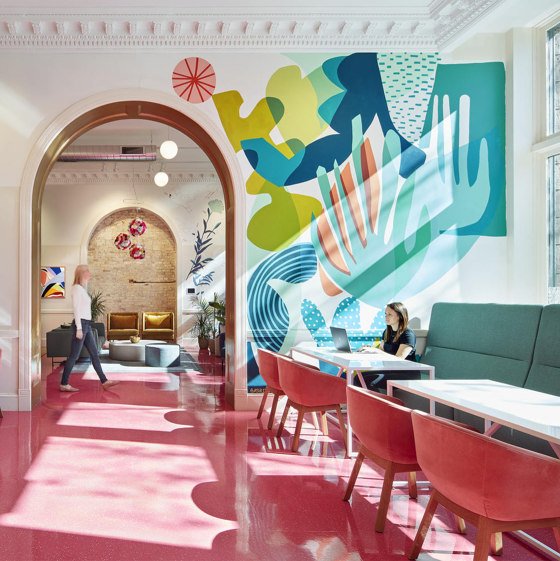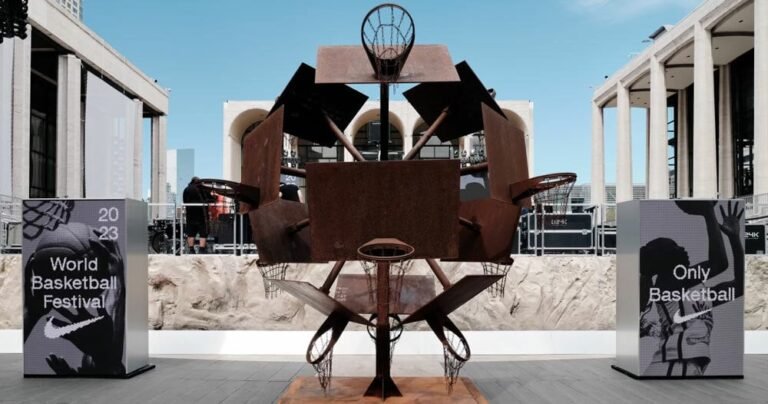Vilhelm Lauritzen Architects Designs Impressive and Efficient Copenhagen Airport Extension Pier E
Pier E balances the dualism between impressive and humble. It is the largest extension of Copenhagen airport in 25 years with more than eight gates, 15 bus gates, and the mandatory control, transfer, and check-in zones distributed on four floors. The building is intense but subtle of an uncompromisingly high quality. With its Nordic aesthetic, the 36,000 m2 building distributes air passengers to and from their gates. It is a rigorous and rational building, but inside there are many small subtleties that tie it all together. The solutions are both incredibly beautiful but also created as a long-lasting building.
Architizer chatted with Simon Svensson, senior partner at Vilhelm Lauritzen Architects, to learn more about this project.
Architizer: What inspired the initial concept for this design?
Simon Svensson: For more than 80 years and three to four generations of expanding Copenhagen-airport, we have deeply rooted experience and familiarity with balancing the requirements of these complex projects. With this design concept, we balanced rationality and an efficient form of “hygge” with a strong materiality approach relating to our legacy of buildings at Copenhagen airport.

© Rasmus Hjortshøj
What do you believe is the most unique or ‘standout’ component of the project?
The key component of this project was the good collaboration with everyone involved. It created a framework, which made it possible to create this unique airport construction with a client that chose to invest in high quality architecture through-and-through. Pier E was the largest expansion of Copenhagen Airport in 25 years, which meant a great focus on securing an architectural legacy, while creating a new. All the way from volume to detail, we have balanced the dualism between impressive and intense yet still subtle and humble. Pier E has become this spatial flow machine bathed in daylight, with floating walkways lined with ash wood lamellas complemented by in-situ cast concrete, integrated furniture and artworks, and marble terrazzo floors.

© Rasmus Hjortshøj
What was the greatest design challenge you faced during the project, and how did you navigate it?
The greatest challenge we encountered was to comply with the Building Code, as it does not cater to the airport typology. We created a super open and -closed building. The building had to be carefully closed to comply with heat loss and cooling requirements. So how do you allow enough light to pass while consecutively ensure an energy-efficient building? We focused on the skylights, which, together with large façade windows, provide generous daylight that highlights the spatiality and materials.
How did the context of your project — environmental, social or cultural — influence your design?
We are privileged with the context of this project as we have designed a key icons of Copenhagen Airport since the first building in 1939, now known as the Vilhelm Lauritzen Terminal. A building that were to lay the foundation of many of the global airport typology elements still used today. In 1960, we built Terminal 2 and subsequently, we built Terminal 3 in 1998.
We have the airport’s entire design and material palette since 1939 for inspiration. We designed pier E by reflecting and reference to our the historic airport context from materials to design choice in new ways. As an example you can see how Pier E reference the 1960 design of Terminal 2 a complex, flow-optimized airport structure where balconies, floating walkways, and a generous influx of daylight form a coherent expression.

© Rasmus Hjortshøj
What drove the selection of materials used in the project?
Durability and maintenance are carefully orchestrated in all the design choices for Pier E. A public building handle tens of millions of passengers every year. How do you design super robust and reliable materials and solutions that are refined, high-quality and welcoming? We created a combination of materials that ensures longevity and graceful patina.

© Rasmus Hjortshøj
What is your favorite detail in the project and why?
Initially, we had a slight aversion against the angle midway of Pier E, but we became to love it. The angle of the building layout is due to an intricate combination of aeronautical geometrical restriction. In the process, we focused on ensuring that all the material joints fit perfectly and it required exquisite artisanship, it is here where the entire ends meet at you can start to unravel the subtle logics architectural finesses of the building.
Our integrated benches along the façade also has a nice touch of our design mindset of how to intertwine functions. It works both as a piece of furniture and conceals loads of radiators while ensuring loads of easily accessible electrical outlets for all the passengers devices. The bench consists of solid ash wood with recessed leather seat pads and frees up loads of space in a gate designed to cater for flights up to airbus A380.

© Rasmus Hjortshøj
How important was sustainability as a design criteria as you worked on this project?
Sustainability is an integral part of the project. The building had to be long lasting, which also meant that there was a strong focus on robustness and long lasting. Sustainable buildings are those versatile and optimized to last forever. This requires high-quality materials, which the client also prioritized.
The vision behind Pier E is inspired by the architectural vision from the old days, where the sustainability thought was to build a robust building that could last. Pier E is built to last; with flexible and durable solutions, so the building can easily be adapted as needed.
As an example the lamellas in the ceiling are mounted so they can be pushed aside as a horizontal curtain, which gives great flexibility in the future by creating easy access to access cables, ventilation ducts, and when incorporating new technologies in the future.

© Rasmus Hjortshøj
In what ways did you collaborate with others, and how did that add value to the project?
Throughout the entire design and construction process, we have had a close dialogue sitting and working psychically together with all our partners and specialists. It provided a common understanding of the project and an even greater understanding for different professionals. It also made solving issues for multiple disciplines at once an integrated part of the collaboration. The dialogue provided a unique opportunity for everyone to contribute with individual skills. During the entire preparation from start to finish, we sat in a common project office, which provided great value for the construction, because it was not far from thought to common dialogue. The client chose to have their own construction management, which meant they took and very active part already in the design process.

© Rasmus Hjortshøj
Were any parts of the project dramatically altered from conception to construction, and if so, why?
Early on in the first part of the construction phase, we agreed on which basic ideas were important. We created some very specific and detailed principles and geometries in the very beginning that are still clear and present. We have managed to maintain a very holistic approach during this project because we early set clear design principles, which has meant that everyone were at the forefront of many solutions as both engineers, users and contractors had the same clear understating of the design principles.
How have your clients responded to the finished project?
Shortly before the opening of the building, I received a forwarded email from an employee that had worked at the airport for 38 years. He wrote, “I think you should be proud of this building. It is incredibly thought through. The more time you spend moving around in the building, the more you discover all the integrated solutions and realizes all the careful considerations”. He also complimented the elegant operational solutions that we had focused on in the process. He noticed that the solutions, that meets the eye as simple are complex and based on many considerations and thoughts. To me, it was one of the biggest and most important compliments.

© Vilhelm Lauritzen Architects
What key lesson did you learn in the process of conceiving the project?
The most important thing we learned was the importance of architects to always take a genuine interest in other professions and professionals. By taking an interest in our partners and collaborators and trying to understand them, we were able to create fantastic results. For example, we had a fantastic collaboration with our concrete and formwork supplier. Pier E has in-situ cast concrete, and it is razor sharp, which is full merit to the contractors dedicated foreman. Typically, you make elements and assemble them on the construction site. We prioritized in-situ concrete, which gives Pier E a clean and pristine look. Before working with the supplier, we had tried in advance to gain a deep understanding of their area, which also made it easier to reach a common goal for how we should meet the strict design requirements.
How do you believe this project represents you or your firm as a whole?
Pier E is intense yet still subtle of an uncompromisingly high quality, which is classic Vilhelm Lauritzen Architects. This year is our centennial anniversary and we carry on the legacy from 1922 by noted architect Vilhelm Lauritzen. He was a humble man, and he created breathtaking aesthetic functionalism completely new at the time and became one of Denmark’s most recognized architects and one of the founders of Danish Modernism. You can compare Pier E with the 1956 People’s House in Copenhagen by Lauritzen – a listed, national modernistic icon in Denmark. It consists of a hard and strict facade, but inside it is a polished and fun universe filled with art and custom made design. The same goes with Pier E. The building is an incredibly rigorous and rational building, but inside there are a lot of small subtleties that tie it all together – from the large scale down to the smallest detail
How do you imagine this project influencing your work in the future?
The fact that we have made a super operationally reliable, heavily loaded, and complex building so simple was important. During the preparation of Pier E, we made competitive proposals for the new extension of Terminal 3. We had living proof in advance of what we as a team could offer. It must have been a positive impact that we had Pier E in the back catalog when we entered the competition. They knew we had good collaboration across the team and good user involvement. Terminal 3 Expansion is expected to be completed in 2028, with an extension of 80,000 m2. Architecturally, the expansion unites the existing qualities with simple solutions that ensure that it is equally spectacular, simple, and calm.

© Rasmus Hjortshøj
Is there anything else important you’d like to share about this project?
During the design phase, we were given specific model requirements. However, we had the ideas, which meant going beyond those requirements would get a better result. To be able to communicate and coordinate these choices, we used strategically increased detailing in the BIM models to ensure our vision. It is about architecture, it is about communicating and it is about getting the best result. With this “strategic modeling”, we could show our thoughts and vision – and raise the level of information across all trades and disciplines.
Team Members
Copenhagen Airport A/S, COWI A/S and ZESO architects A/S
Products / Materials
In-situ cast raw concrete, ash wood lamellas, marble terrazzo floors, and aluminium sheating backing panels.
For more on Copenhagen Airport Pier E, please visit the in-depth project page on Architizer.



